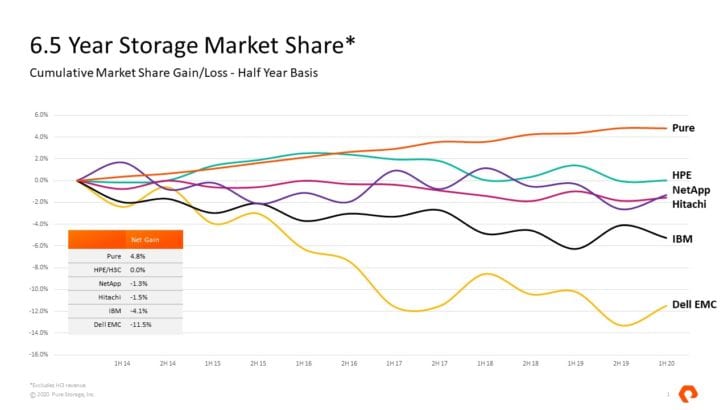You’d think a company that’s been around as long as Dell EMC would know better than to make a big fuss about the feeds and speeds of its midrange PowerStore systems like it did recently in CRN magazine. The world has moved on. Today’s enterprise IT leaders care a lot more about business outcomes and IT agility than data-transfer protocols.
Before joining Pure Storage®, I worked at NetApp and Nimble Storage. I’ve had plenty of experience losing sales to Pure. One of the biggest lessons I’ve learned along the way is that IT organizations are deeply committed to providing their end users with an awesome online experience. They may have emphasized hardware and software a few decades ago, but now they’re centered on adding business value.
That’s why it’s weird to see Dell EMC focus on technological differentiation for workloads, scale, and topology. Let’s break these down:
- Any workload: While PowerStore supports block, file, vVols, and container workloads, you have to dig into the specifics for accuracy. PowerStore T (running in unified mode) supports block and file, but PowerStore X doesn’t. That means VMs running on PowerStore X only support vVols. Pure Storage and most of the competition can run any workload, so the details here are important.
- Any scale: It’s the same story with scale up and scale out: Both Pure FlashArray™ and Dell EMC PowerStore scale up. But FlashArray is end-to-end NVMe while PowerStore still uses legacy SAS-attached shelves. Quite frankly, it’s really a stretch to claim that PowerStore also scales out. In fact, only PowerStore T is capable of simply federating appliances under the same management interface with data volumes owned by the parent appliance’s data controllers. That means you’ll need to do a manual migration for load balancing. Read more about it in “Uncovering Dell EMC’s PowerStore B.S. (Bogus Statements).”
- Any topology: It’s important to keep in mind that Dell EMC’s AppsON is available only on PowerStore X models and doesn’t offer a scale-out architecture when in use, which breaks the “any scale” claim.
What Customers Think
Customer experience is the real differentiator in modern enterprise storage. The latest market research numbers confirm what industry analysts have been saying for years: Pure Storage continues to gain market share while the rest of the leading data storage vendors experience continuing decline (Figure 1).

In ratings based on customer reviews, Pure FlashArray achieved a 4.9 out of 5 in the Gartner Peer Insights program and a 9.2 out of 10 on TrustRadius. Plus, Pure has a market-leading Owen CX-certified Net Promoter Score (NPS) of 82—in the top 1% for B2B companies.
Goodbye, Forklifts. Hello, Peace of Mind
There’s a simple reason for this trend: Evergreen Storage™. Evergreen offers a fundamentally different ownership experience compared to the old way of buying data storage. For a decade, Pure customers have enjoyed the extraordinary peace of mind that comes from knowing they’ll never need another forklift upgrade. Gone are the days of re-buying the same storage capacity every few years to address obsolete storage architectures. With Evergreen, you get a true subscription to innovation, enabling you to non-disruptively modernize and enhance storage controllers, flash media, and other components. That means real agility to respond to business changes.
And unlike convoluted plans that try to cram a CAPEX purchase into an OPEX framework, Pure provides a true storage-as-a-service option—a utility for which you’re billed only on actual consumption. Factor in Pure’s industry-leading NPS, and you can see why Dell EMC is trying to position PowerStore on the basis of scant technological differentiation.
The real competition between FlashArray and PowerStore isn’t about containers and storage topologies. It’s taking place in the marketplace, where customers are overwhelmingly deciding in favor of the Pure Storage experience.
![]()




